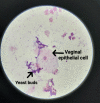Assessment of Symptoms and Risk Factors as a Screening Tool of Bacterial Vaginosis Among Reproductive Age-Group Females in West Bengal, India
- PMID: 37916250
- PMCID: PMC10616802
- DOI: 10.7759/cureus.46310
Assessment of Symptoms and Risk Factors as a Screening Tool of Bacterial Vaginosis Among Reproductive Age-Group Females in West Bengal, India
Abstract
Background Bacterial vaginosis (BV) is a ubiquitous vaginal discomfort and has overlapping symptoms with other reproductive tract infections. The World Health Organization suggested a symptomatic approach for diagnosing BV with insufficient laboratory setup. However, due to symptom overlap, BV is often misled and ends up with injudicious drug application. Objective The study aims to identify the most relevant symptoms and behavioral risk factors associated with BV in tertiary healthcare settings in West Bengal, India. It also seeks to develop a scoring system based on clinical symptoms to screen for BV, especially when laboratory facilities are limited. Methodology The study is a retrospective case-control study involving 95 women of reproductive age. It employs both univariate and multivariate binary logistic regression models to identify risk factors and symptoms associated with BV. The study also compares these clinical symptoms with laboratory tests (Amsel's test) and attempts to create a scoring system for BV diagnosis. Key Findings Good menstrual hygiene and condom use were identified as key behavioral practices reducing the risk of BV. Four clinical symptoms, like malodor (P = 0.007), lower abdominal pain (P = 0.015), abnormal vaginal discharge (P = 0.071), and painful intercourse (P = 0.08), were identified as notable predictors. Based on these four symptoms, the scoring system showed a sensitivity of 88.2%, a specificity of 67.25%, and an overall accuracy of 74.7%. An additional diagnosis of vulvovaginal candidiasis (VVC) revealed that the odds of malodor (P= 0.006) and burning sensation (P= 0.011) increased significantly during co-infection.
Keywords: bacterial vaginosis (bv); risk factors for bv; screening tool; syndromic diagnosis; valvovaginal candidiasis.
Copyright © 2023, Nuzhad et al.
Conflict of interest statement
The authors have declared that no competing interests exist.
Figures



References
-
- Correlates of bacterial vaginosis among women from North India. Challa A, Kachhawa G, Sood S, Upadhyay AD, Dwivedi SN, Gupta S. Int J STD AIDS. 2022;33:666–671. - PubMed
-
- Nonspecific vaginitis: diagnostic criteria and microbial and epidemiologic associations. Amsel R, Totten PA, Spiegel CA, Chen KC, Eschenbach D, Holmes KK. Am J Med. 1983;74:14–22. - PubMed
LinkOut - more resources
Full Text Sources
